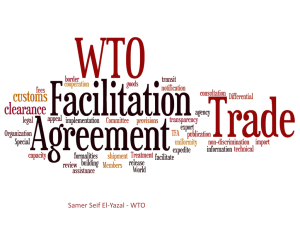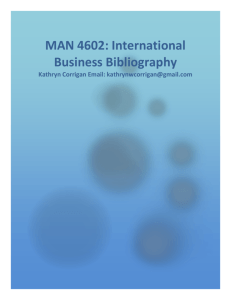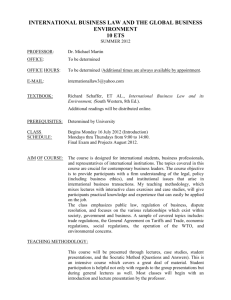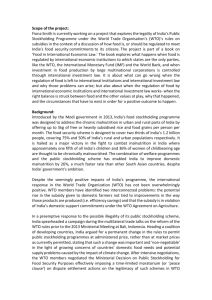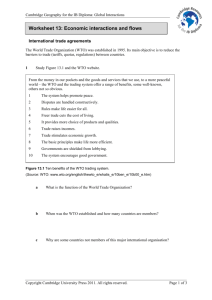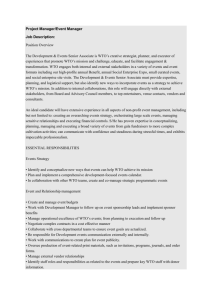Information Available Through Internet
advertisement
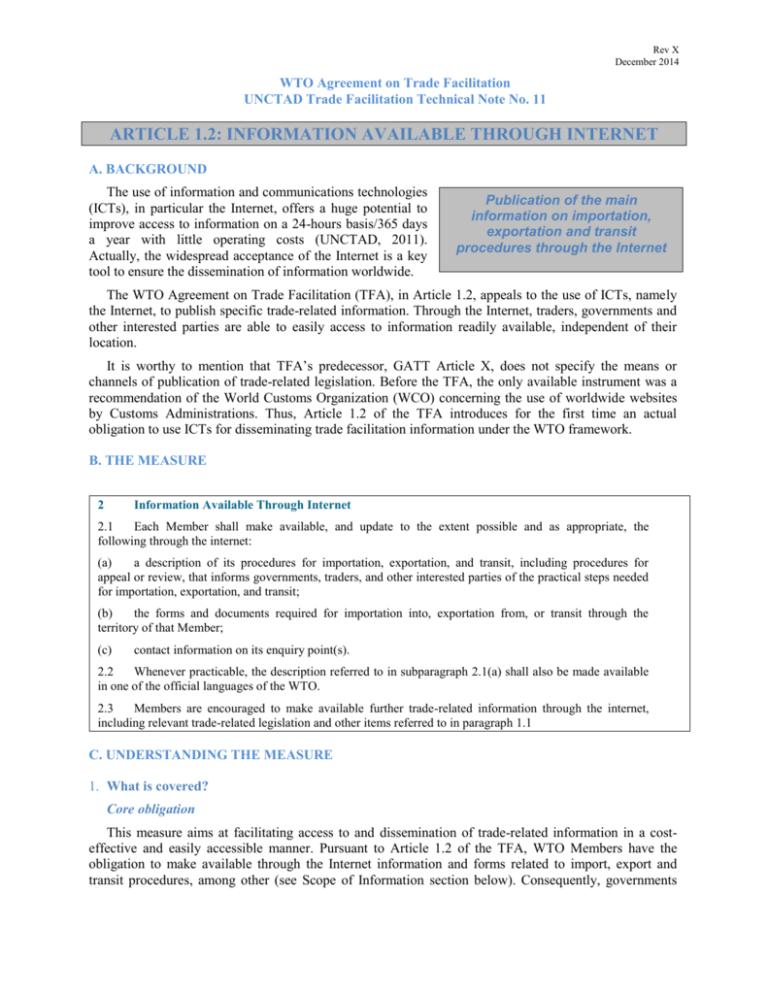
Rev X December 2014 WTO Agreement on Trade Facilitation UNCTAD Trade Facilitation Technical Note No. 11 ARTICLE 1.2: INFORMATION AVAILABLE THROUGH INTERNET A. BACKGROUND The use of information and communications technologies (ICTs), in particular the Internet, offers a huge potential to improve access to information on a 24-hours basis/365 days a year with little operating costs (UNCTAD, 2011). Actually, the widespread acceptance of the Internet is a key tool to ensure the dissemination of information worldwide. Publication of the main information on importation, exportation and transit procedures through the Internet The WTO Agreement on Trade Facilitation (TFA), in Article 1.2, appeals to the use of ICTs, namely the Internet, to publish specific trade-related information. Through the Internet, traders, governments and other interested parties are able to easily access to information readily available, independent of their location. It is worthy to mention that TFA’s predecessor, GATT Article X, does not specify the means or channels of publication of trade-related legislation. Before the TFA, the only available instrument was a recommendation of the World Customs Organization (WCO) concerning the use of worldwide websites by Customs Administrations. Thus, Article 1.2 of the TFA introduces for the first time an actual obligation to use ICTs for disseminating trade facilitation information under the WTO framework. B. THE MEASURE 2 Information Available Through Internet 2.1 Each Member shall make available, and update to the extent possible and as appropriate, the following through the internet: (a) a description of its procedures for importation, exportation, and transit, including procedures for appeal or review, that informs governments, traders, and other interested parties of the practical steps needed for importation, exportation, and transit; (b) the forms and documents required for importation into, exportation from, or transit through the territory of that Member; (c) contact information on its enquiry point(s). 2.2 Whenever practicable, the description referred to in subparagraph 2.1(a) shall also be made available in one of the official languages of the WTO. 2.3 Members are encouraged to make available further trade-related information through the internet, including relevant trade-related legislation and other items referred to in paragraph 1.1 C. UNDERSTANDING THE MEASURE 1. What is covered? Core obligation This measure aims at facilitating access to and dissemination of trade-related information in a costeffective and easily accessible manner. Pursuant to Article 1.2 of the TFA, WTO Members have the obligation to make available through the Internet information and forms related to import, export and transit procedures, among other (see Scope of Information section below). Consequently, governments shall ensure that the covered information is uploaded and readily available to any traders, government or other interested party. As procedures and requirements may change over time, Article 1.2 also requests WTO Members to update their website(s) in order to provide the most accurate information to relevant stakeholders. Nonetheless, the obligation to update was to some extent neutralized by adding the terms “to the extent possible” and “as appropriate”. In other words, both terms bring some degree of flexibility in the compliance of the obligation to update. The term “to the extent possible” requires that WTO Members undertake serious efforts to update the information available on the Internet (Panel reports, EEC - Restrictions on Imports of Apples from Chile). In case of incompliance, the concerned WTO Member will need to prove that, in spite of its efforts, it was impossible to comply with it, taken into account the relevant circumstances on a case-by-case basis. While the use of the term “as appropriate” might induce a certain level of flexibility in meeting the update requirement, WTO Members remain obliged to comply with this requirement. According to WTO Panels “[t]he word appropriate, in its general dictionary sense, means especially suitable, proper. This suggests that “appropriate measures” are those that are suitable for achieving their purpose” (Panel reports in, Mexico-Telecom, EC-Tube or Pipe Fittings, US-Clove Cigarettes). Therefore, the term “as appropriate” leaves to WTO Members the choice regarding the suitable method to update the information on the Internet. Scope Pursuant to Article 1.2 of the TFA, WTO Members are obliged to upload into the Internet at least the following information: a) A description of import, export and transit procedures; b) A description of procedures for appeal or review; c) Forms and documents required for importation, exportation and transit; and d) Contact information on enquiry points. While GATT X is mainly related to publication of the legal basis of these procedures and Article 1.1 of the TFA requests the publication of information as such, Article 1.2 of the TFA requests WTO Members to undertake further actions. Thereby, WTO Members shall provide a practical explanation of the different steps composing the procedures for importation, exportation and transit. The aim is that relevant stakeholders obtain a comprehensive understanding on how to import to, export from, or transit through the territory of the concerned WTO Member. A footnote to Article 1.2.1(a) points out that each WTO Member has the discretion to state on its website the legal limitations of these descriptions. This means that WTO Members may include a note restricting the legal validity of this description. For instance, it may be a sort of disclaimer stating that this description available on the Internet does not replace the actual legal basis. Other trade-related information The TFA also encourages WTO Members to publish on the Internet additional trade-related information, including the legal basis and the items referred to Article 1.1 of the TFA (See Technical Note No. 1 on Publication). Due to its best-endeavour nature, WTO Members have the discretion whether to make available on the Internet further trade-related information. 2 Language The TFA also requests WTO Members to make the description of import, export and transit procedures, including appeal and review procedures, in one of the official languages of the WTO (English, Spanish or French), whenever practicable. According to its ordinary definition, the term “practicable” means “able to be done or put into practice successfully” (Oxford dictionary). Thus, a WTO Member is expected to translate and make these descriptions available through the Internet in one official WTO language as far as it has the technological capacity and the resources, both financial and human resources, to do so. 2. What is not covered? Article 1.2 does not require WTO Members to publish the information on one centralized website. Thus, the information published on the Internet can be mirrored on several sites (UNCTAD, 2011). In all cases, WTO Members shall ensure that the information is identical in all sites in order to set up a predictable environment for relevant stakeholders. The TFA does not specify if the information should be uploaded by a governmental agency. Thus, it is possible that WTO Members delegate this task to private entities. In that case, it would be of utmost importance that the concerned WTO Member monitors the accuracy and authenticity of such information. D. IMPLEMENTATION ISSUES UNCTAD Study In a recent study entitled "The new frontier of competitiveness in developing countries: Implementing Trade Facilitation", UNCTAD analysed the implementation status of TF measures in 26 developing countries, including least-developed countries (LDCs), middle-income developing countries, landlocked countries, transit developing countries, and small island economies in Africa, Asia, the Caribbean and Latin America (UNCTAD 2014). As to the measure “information through Internet”, out of twenty-six participating countries, two countries (8%) reported a full level of implementation and other two countries considered that the measure was not implemented at all; while twenty-two (84%) reported a partial implementation. This particularly high percentage of “partial implementation” is due to the fact that this measure requires the collaboration and information from a large number of agencies, and very often some agencies (e.g. Customs) already provide all relevant information on the internet, while some other agencies do not do that. TF stakeholders in the participating countries claimed that the main reasons for non-implementation were: lack of resources (mentioned by 76 % of the countries), lack of the organizational and institutional framework (64 %) and lack of inter-agency cooperation (56 %). Stakeholders also quoted lack of capacity of the economic operators as a reason for partial implementation of the measure. 3 Implementation Check List The following list may be used as guidance when estimating the level of compliance with the measure: There is legal or administrative procedure or established practice to publish through the Internet the information listed in the article All items of the required information are published in the Internet. Information is published promptly and updated when modified, and if not, a country explains why it was not possible or appropriate. All items of the required information are in one of the WTO official languages. The issue of the legal validity of the information published on the Internet is addressed/clarified. Preparing a national implementation plan The following table may be used as a basis for the national implementation plan for this measure. Recommended implementation method Actions required Preparatory stage 1.1 Take legal or administrative measures to introduce or formalize the obligation to officially publish and update the required information 1.2 If needed, designate a focal Ministry/Department in the country responsible for overseeing that all the required information is published on the Internet. Set up 2.1 Create/Update the information management system for publishing information on the internet 2.2 Update/Develop a comprehensive information technology (IT) strategy 2.3 Address the issue of information security 2.4 Address or clarify the issue of the legal validity of information published on the internet Time for implementation Leading implementation agency Management and follow-up Periodical monitoring and evaluation of the situation with respect to publication on the Internet The estimated implementation time ranges/is between two and three years, on average Ministry in charge of Trade is most commonly chosen as the leading implementation agency References - - Panel Report, European Communities – Anti Dumping Duties on Malleable Cast Iron Tube or Pipe Fittings from Brazil, WT/DS219/R, adopted 18 August 2003, as modified by Appellate Body Report WT/DS219/AB/R, DSR 2003:VII, p. 2701. Panel Report, EEC - Restrictions on Imports of Dessert Apples, L/5047, adopted on 10 November 1980, 27S/98, 117, paras. 4.22-4.23. Panel Report, Mexico – Measures Affecting Telecommunications Services, WT/DS204/R, adopted 1 June 2004, DSR 2004:IV, p. 1537. 4 - Panel Report, United States – Measures Affecting the Production and Sale of Clove Cigarettes, WT/DS406/R, adopted 24 April 2012, as modified by Appellate Body Report WT/DS406/AB/R, DSR 2012: XI, p. 5865. UNCTAD, Technical Notes on Trade Facilitation Measures, Geneva: United Nations, 2011 p.61. UNCTAD, The new frontier of competitiveness in developing countries: Implementing trade facilitation, 2014. WCO, Recommendation of the Customs Co-operation Council concerning the Use of Worldwide Websites by Customs Administration adopted on 26 June 1999. The Technical Notes have been produced by a technical expert contracted by UNCTAD under different Trade Facilitation projects financed by the Governments of Norway, Sweden, Switzerland and Spain as well as the European Union. Their purpose is to assist policy makers and other Trade Facilitation stakeholders to better understand the scope and implications of the various trade facilitation measures included in the WTO Trade Facilitation Agreement (TFA) and prepare for their implementation. The opinions expressed in the Technical Notes may not necessarily coincide with those of the organization or the donors of the Trust Fund. The Technical Notes have not been formally edited. For comments and enquiries please contact TF@UNCTAD.org. All Technical Notes are available via http://www.unctad.org/technicalnotes. 5
